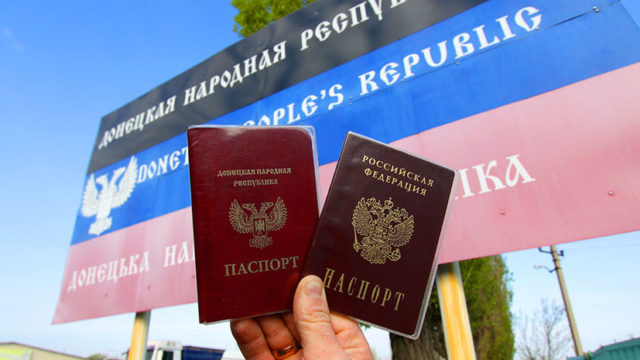
Conflict Conservation in Ukraine’s Donbas Follows the Transnistria Model (Part Two)
Publication: Eurasia Daily Monitor Volume: 17 Issue: 120
By:

*To read Part One, please click here.
Elements of the Transnistria conflict-conservation model are taking shape in Ukraine’s Donbas conflict theater, with moves to recast Russia’s state-on-state aggression as an inner-Ukrainian conflict. The July 22 enhanced ceasefire agreement and the preconditions just confirmed for holding another “Normandy Format” (Ukraine, Russia, Germany, France) summit follow this model’s successive footsteps (see Part One in EDM, August 12).
4) Relegating the conflict from the inter-state to the local (internal) level is the basis for the “freeze” in Transnistria on Russian-imposed terms. These define Chisinau and Tiraspol as parties to the conflict, the ceasefire arrangements, and an eventual political settlement that they should negotiate directly, with Russia as an arbiter. Moldova accepted these basic terms early on, amid Western indifference followed by Western consent. In Ukraine’s case, Russia aims to infiltrate the Transnistria model into the Minsk Contact Group, where Donetsk and Luhansk hold the status of “participants.” Russia seeks to position itself alongside the Organization for Security and Cooperation in Europe (OSCE) as mediator to direct negotiations between Kyiv and Donetsk-Luhansk. In this it failed for five years until the Volodymyr Zelenskyy administration gave Russia three openings: a) acceptance of the Steinmeier Formula for incorporation into Ukraine’s legislation through direct negotiations between Kyiv and Donetsk-Luhansk (ongoing in the Minsk Contact Group); b) the “consultative council” of Kyiv and Donetsk-Luhansk, with Moscow positioned between them (project halted by a Ukrainian public backlash); and c), with far-reaching potential consequences, the July 22 ceasefire agreement, equalizing Ukraine’s armed forces with those of Donetsk-Luhansk as contracting parties to the ceasefire and, by extension, to the conflict as such, while exonerating Russia, along the lines of the Transnistria model (see EDM, July 29, 30, August 5, 6).
5) “Special Status” as an instrument for state fracture. Russia coerced Moldova in the early 1990s and Ukraine in 2014–2015 (Minsk “agreements”) into consenting to endow Transnistria and “certain areas of the Donetsk and Luhansk regions” (ORDLO), respectively, with a special constitutional status. (The “special status” occasionally morphed into “federalization” in 2003 in Moldova and in 2014 in Ukraine, but those were episodes.) In this respect also, Russia follows its own Transnistria model in ORDLO. In both cases, the putative Special Status would a) crown direct negotiations on an equal footing between the national government and the Russian-installed leadership of Transnistria or ORDLO; b) not be granted (handed down) from the center, but contracted between equal parties (thus not revocable by the central government), and constitutionally enshrined on a permanent basis; c) endow the Russian-installed leaderships in those territories with quasi-sovereign powers; d) preserve the fiction of Moldovan or Ukrainian territorial integrity and sovereignty while creating de facto Russian-controlled states-within-states; e) reinsert these into Moldova’s or Ukraine’s political systems with a view to upending them; f) stimulate centrifugal tendencies in certain other Moldovan or Ukrainian territories, resulting in demands for special treatment and ultimate fragmentation.
6) Internal constitutional transformation as a substitute for inter-state peace. Russia’s state-on-state conflict undertaking would not end with an inter-state peace settlement (which would confirm that Russia was a belligerent), but would instead result in an internal pseudo-constitutional settlement forced upon the aggressed state. Moscow’s pursuit of the special-status projects against Moldova and Ukraine over the course of almost three decades is a tribute to Russia’s sense of strategic purpose. The European Union and the United States pay diplomatic lip service to the “special status” for Transnistria; while Germany and France profess allegiance to the Minsk “agreements,” the political centerpiece of which is a quasi-sovereign “special status” for ORDLO.
7) The Russian World. In both Transnistria and ORDLO, Russia is successfully experimenting with enlarging the Russian World beyond the Russian Federation’s current official borders. Russia and the Transnistrian authorities set a pattern for this experiment in the early 1990s, followed since 2014 in ORDLO’s version, reflecting local circumstances but also the evolution of Russia’s own state ideology during that period. While local circumstances are distinct from case to case, the commonalities are unmistakable in Moscow’s handling of Transnistria and ORDLO: building on the foundations of Soviet identity to develop the Greater-Russia identity, mass-scale Russian passportization, as well as intensified linguistic and cultural Russification of non-Russians (who form the majority of the population in both Transnistria and ORDLO by the criteria of ethnicity).
8) The rule-of-law dilemma. Any special status, federalism, autonomy or constitutional settlement, however defined, would not operate as written in the absence of rule of law in Ukraine or Moldova. Both countries experience grave deficits in terms of rule of law and are unlikely to overcome this situation any time soon. Any special-status agreements would, in practice, operate as informal, non-transparent deals between power groups and interest networks in Chisinau and Tiraspol, Kyiv and ORDLO, and probably also other territorial power brokers in Ukraine or Moldova. Introducing special-status arrangements in Ukraine and Moldova would fatally reverse any progress in terms of rule of law in either country.



